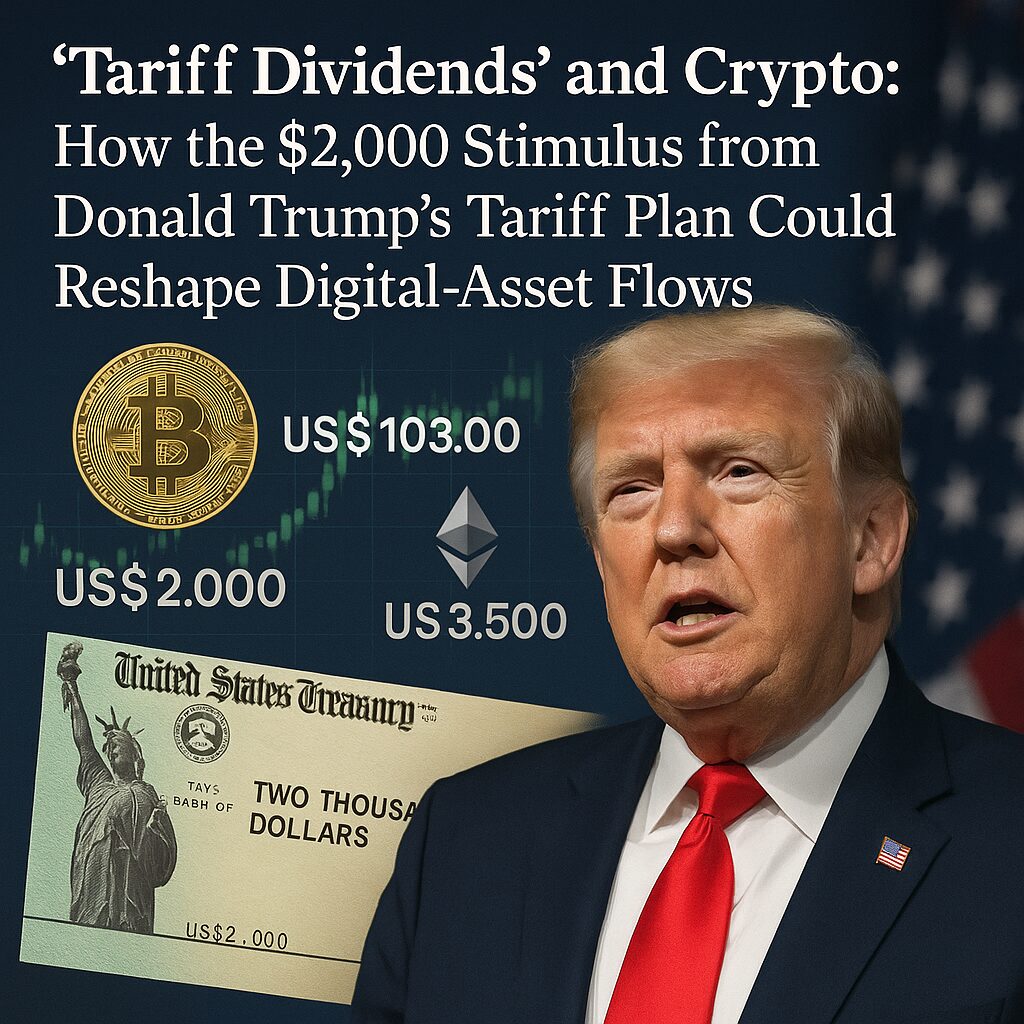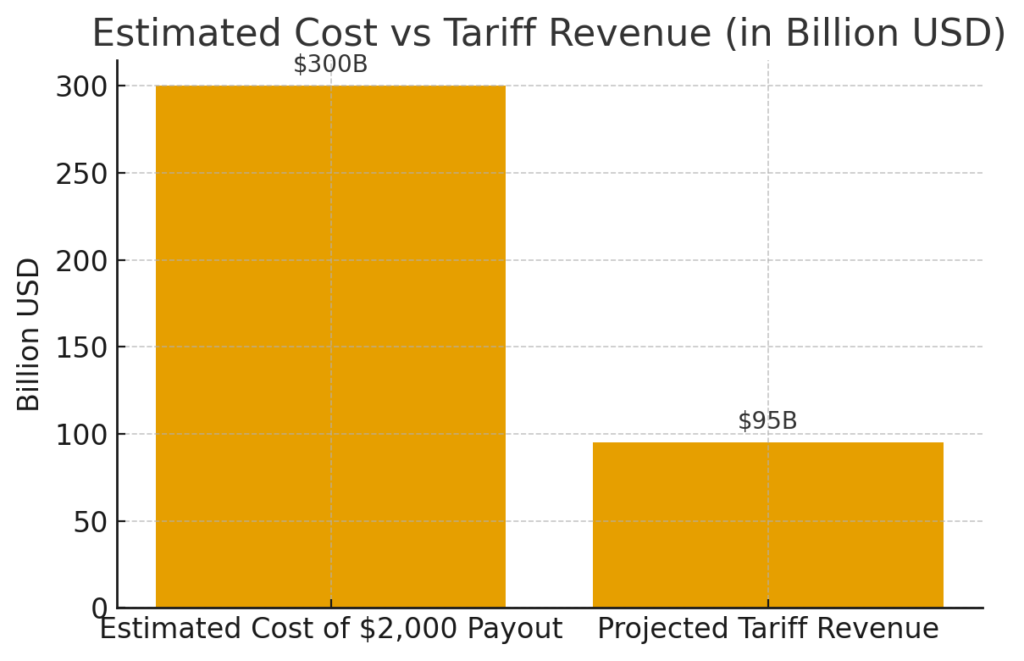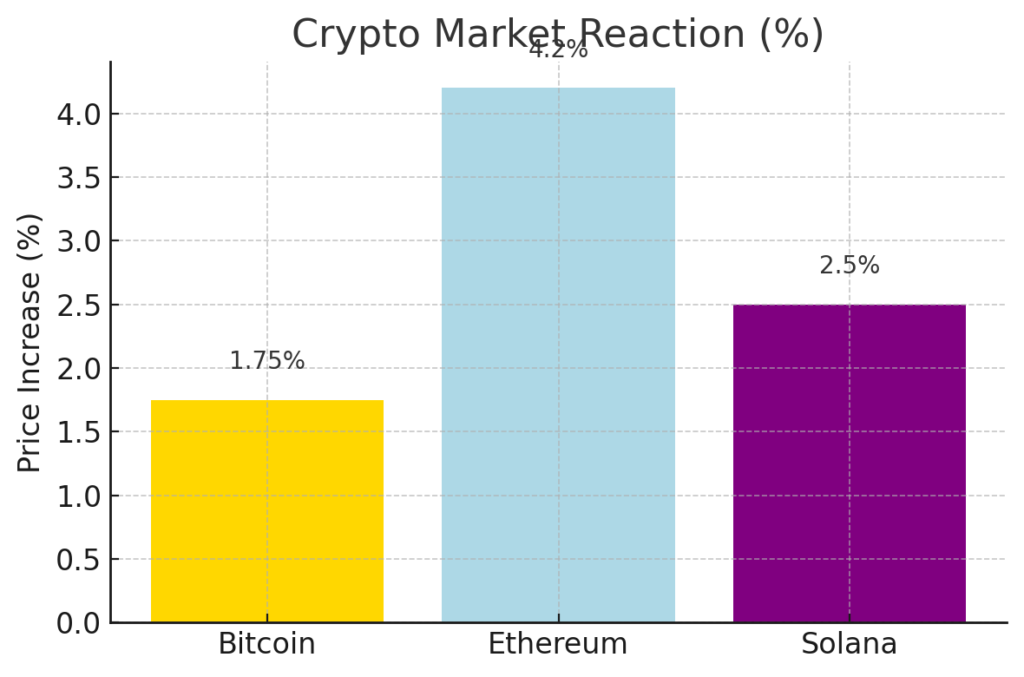
Key Points :
- The U.S. President announced plans to pay most Americans a “dividend” of at least US$2,000, funded by tariff revenues.
- Crypto markets responded immediately: e.g., Bitcoin rose above US$103,000, and Ethereum surpassed US$3,500.
- Legal and fiscal constraints: the plan’s legality is under the U.S. Supreme Court, and tariff revenues may fall well short of funding the payout.
- Macro risks for crypto: stimulus may boost asset prices short-term but could fuel inflation, harm fiat currency purchasing power and redirect liquidity flows.
- For blockchain / crypto-asset investors: this event presents a potential asset-flow trigger, but requires nuance, timing insight, and risk awareness.
1. Background: The Dividend Announcement

On Sunday, President Donald Trump posted on Truth Social that “a dividend of at least US$2,000 per person (excluding high-income earners!) will be paid to everyone” as part of his sweeping trade/tariff agenda. According to the announcement, the funding source is tariff revenues generated from his trade policies—he claimed the U.S. is taking in “trillions of dollars” in tariffs and that these funds can reduce the approximately US$37 trillion national debt while financing the payout.
However, the plan faces significant legal headwinds: the U.S. Supreme Court is currently evaluating aspects of the tariff policy’s legality, and prediction-markets place the odds of approval at just ~21-23%. Furthermore, tax-policy analysts estimate that even optimistically the tariff revenue falls far short of the proposed payout. For example, if ~150 million adults qualify at US$2,000 each, the total cost approaches US$300 billion; yet net revenue from tariffs may be only ~US$90-100 billion when broader effects are considered.
From a crypto-asset viewpoint, what matters is that this policy could act as a liquidity trigger: additional disposable income flowing to many Americans might find its way into risk-assets—including crypto—especially given the history of stimulus checks sparking asset flows.
2. Immediate Market Reaction & Crypto Flows

Following the announcement, crypto markets responded with a modest rally. Bitcoin rose about 1.75 % to over US$103,000, Ethereum rose around 3-5 % to beyond US$3,500, and other altcoins such as Solana also saw gains (~2-7 %).
The interpretation among market participants: some of the upcoming “dividend” cash may be diverted into risk-assets including crypto, boosting demand and thus prices. One crypto-investor and commentator Anthony Pompliano summed up this view: “Stocks and Bitcoin only know to go higher in response to stimulus.”
For those seeking new crypto assets and income opportunities, this means the payout announcement could act as a catalyst for renewed inflows into digital assets or DeFi sectors. However, the size of that effect, and timing, remain uncertain.
3. The Broader Macro and Blockchain Implications
3.1 Stimulus, Inflation, and Crypto
While stimulus tends to drive asset prices upward in the short term, longer-term consequences can run counter to crypto-friendly narratives. Analysts at the newsletter The Kobeissi Letter estimate that approximately 85 % of U.S. adults would qualify under the policy, based on precedent from the COVID-era stimulus checks.
However, the same analysts warn that such large-scale cash injections can stoke inflation, erode fiat-currency purchasing power, and eventually discourage real savings or investment unless effectively deployed. As one crypto advocate, Simon Dixon, put it: “If you don’t put the US$2,000 into assets, it is going to be inflated away or just service some interest on debt and be sent to banks.”

From a blockchain-application standpoint, inflation fears could boost interest in crypto assets viewed as inflation hedges (such as Bitcoin or certain stablecoins) and drive greater demand for decentralized financial protocols. On the flip side, macro instability and regulatory uncertainty may elevate risk premiums and undermine adoption momentum.
3.2 Liquidity Flows into Blockchain Ecosystem
Given the potential for increased disposable income among U.S. consumers, we might expect a few actionable trends:
- More retail interest in new or emerging tokens (especially those positioned as high-growth or yield-generating).
- DeFi protocols may benefit from increased new capital seeking higher yields amid inflation concerns.
- Established crypto assets (BTC, ETH) may act as liquid entry points ahead of capital deployment into more specialized projects.
For developers and investors working on wallet infrastructure (for example, non-custodial wallets seeking integration of swaps, liquidity pools, etc.), this is a potential window of opportunity: easier onboarding of users who feel “stimulus money” may be available and view crypto as an accessible asset class.
3.3 Legal & Funding Uncertainty
It is worth emphasizing that the dividend proposal remains highly speculative at this stage. The President cannot unilaterally deliver the payout — congressional appropriation and legal clearance are required.
Moreover, the gap between projected cost (hundreds of billions) and realistic tariff revenue (tens of billions) implies that execution may be delayed or ultimately modified. Some analysts see this more as a sentiment-driving announcement than a guaranteed cash event.
When assessing crypto investment strategy in light of this, one must consider that the positive price response may reflect expectation of stimulus rather than the guarantee of funds arriving — a mismatch between sentiment and reality could spark volatility.
4. Strategic Considerations for Crypto Investors & Blockchain Practitioners
Given our audience—investors looking for new crypto assets, income opportunities and practical blockchain use cases—here are actionable considerations:
4.1 Timing and allocation
- If the payout reaches consumers, there may be a short-lived “spend vs invest” choice: some recipients will spend, others may allocate to assets (including crypto). Early positioning into liquid, high-cap assets (e.g., BTC, ETH) may allow either taking profits into emerging tokens or riding the macro flow.
- For smaller cap or new asset projects: if users receive extra cash and decide to explore new tokens or DeFi yields, being ready with strong UX, transparency, and education will matter.
4.2 Use-case relevance: non-custodial wallets and swaps
- In your wallet project (e.g., “dzilla Wallet”), clear UX around how stimulus funds (or any new inflows) can be routed into crypto—via swaps (BTC ↔ ETH), yield modules, or risk/return disclosure—can be a differentiator.
- Educate users about inflation risk and asset allocation strategies: for example, converting fiat stimulus into a diversified basket of assets vs simply parking in fiat or low-yield savings.
4.3 Risk caution & regulatory watch
- A major risk: if the payout is delayed, scaled down, or cancelled, market sentiment could reverse quickly, dragging crypto prices down.
- Inflation concerns, sharper monetary policy responses, or renewed regulatory crackdowns on crypto could offset the boost.
- Legal/regulatory developments: the tariff proposal is under judicial review; for blockchain practitioners the takeaway is that macro policy matters to crypto flows.
4.4 Identifying actionable assets and sectors
- Consider assets with inflation-hedge narratives (e.g., Bitcoin, inflation-resistant stablecoins, asset-backed tokens) as part of the portfolio.
- Explore DeFi protocols targeting U.S. retail onboarding: if stimulus income finds its way into crypto, easily accessible yield-earning protocols might benefit.
- Watch for tokens/platforms that emphasise seamless fiat-to-crypto conversion, especially for users receiving cash and looking to deploy quickly.
5. Longer-Term Outlook & Blockchain Implications
While the immediate headline is about a US$2,000 check, the broader implications for blockchain and digital assets are substantive:
- The concept of “direct cash transfers funded by trade/tariff policy” introduces another channel through which liquidity may enter the crypto system. This is analogously reminiscent of previous pandemic-era stimulus, but with a trade/tariff twist.
- If consumers do receive these dividends and a meaningful fraction flows into digital assets, we might see renewed retail crypto adoption, more token launches timed to the event, and higher demand for wallet infrastructure and educational onboarding.
- However, if inflation accelerates, central banks respond with tighter monetary policy, or fiscal deficits balloon, the narrative could flip: crypto may be caught between inflation-hedge demand and risk-asset retrenchment.
- For blockchain projects, there is a window to emphasise real-world use cases: e.g., tokenised asset-backed representations, cross-border transfers, and non-custodial solutions that serve users newly entering via cash stimulus.
Conclusion
In summary, President Trump’s proposal of a US$2,000 tariff-funded dividend has stirred markets and the crypto sector, acting as a potential liquidity catalyst for digital assets. For investors seeking new crypto opportunities and practitioners building blockchain infrastructure, this represents both a short-term trigger and a longer-term structural moment. The key will be timing flows, aligning product/UX readiness (for wallet builders), and managing risk around inflation, legal/regulatory uncertainty, and macro headwinds. For those positioned well, this may be another opportunity in the evolving “Asset-Backed Representation” vs “Autonomous Trust Tender” dichotomy: the stimulus money (fiat) gets converted into crypto assets (autonomous trust tender) through blockchain rails, and your frameworks, wallets, and protocols can capture that movement.
As always, while the opportunity is real, the execution remains uncertain, so vigilance, diversification, and a well-thought exit strategy remain essential.

